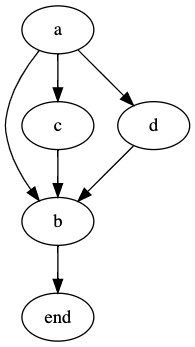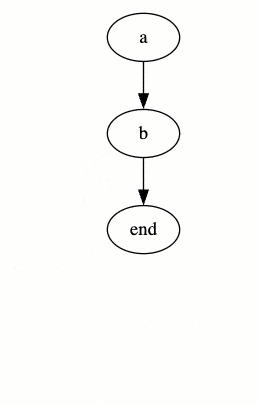multi-step-graphviz v1.0.2
Graphviz Steps Parser
Graphviz files parser to allow multiple Graphviz sequences in one file.
Have you ever wanted animated Graphviz diagrams? The kind you see when you look at the demos in d3-graphviz.
You could just use d3-graphviz, but you have to code all the examples and create new dot source strings for each step in the animation.
Or you can use the Graphviz Steps Parser which parses a Graphviz dot string with some extra annotations as comments, and it identifies each step in the diagram and helps you generate sequences of dot strings suitable for animating via the d3-graphviz library.
Quick Example
This Graphviz dot source, has 3 steps in it, you can spot them as the # comments in the source.
digraph G {
a -> b
# STEP add c
a -> c
c -> b
# STEP add d
a -> d
d -> b
# END
b -> end
}This will still render as a normal Graphviz diagram:

If you use the same source with Graphviz Steps Parser to parse it into individual dot strings then you can render each of them using d3-graphviz then you can render it as an animated graph.

Using it yourself
If you are familiar with Javascript then you should be able to get started by looking at the source code for the generate.demo.html application.
Until we create a proper editor, if you want to work from your own dot file you can:
- open editor example
- click anywhere on the screen
- paste in your Graphviz graph at the input prompt
- click OK
For web usage you can include the
graphviz-step-parser.jsfrom thedistfolder:
<script src="graphviz-step-parser.js"></script>You also need to add the d3-graphviz dependencies:
<script src="https://cdnjs.cloudflare.com/ajax/libs/d3/7.8.0/d3.min.js"></script>
<script src="https://cdn.jsdelivr.net/npm/@hpcc-js/wasm/dist/graphviz.umd.js" type="javascript/worker"></script>
<script src="https://cdnjs.cloudflare.com/ajax/libs/d3-graphviz/5.0.2/d3-graphviz.min.js"></script>A simple npm usage example
https://www.npmjs.com/package/multi-step-graphviz
npm install multi-step-graphviz
Then using require:
var GraphvizSteps = require('multi-step-graphviz');
var stepDot=`
digraph G {
a -> b
# STEP add c
a -> c
c -> b
# STEP add d
a -> d
d -> b
# END
b -> end
}`;
var stepParser = new GraphvizSteps.GraphvizStepParser();
stepParser.parse(stepDot);
var dots = stepParser.dotVersions;
console.log(dots.length);
console.log(dots[0]);
console.log(dots[1]);
console.log(dots[2]);Basic Example
All directives to control the animation are added as "#" comments in the Graphviz.
e.g.
digraph G {
a -> b
# STEP
b -> c
# END
}The two most important are:
- "# STEP" lines under this are part of a step
- "# END" everything after this is the end of the graph
Everything before the first "# START" is included in all animation steps.
e.g. the example above converts into two graphs
digraph G {
a -> b
}digraph G {
a -> b
b -> c
}Reference
- All directives should be added to the graph as
#comment lines e.g.# STEP - There are 3 top level directives
STEP,END,DIRECTIVE - All animated Graphs should have an
ENDdirective comment to make sure the generated graph is valid - A
STEPdirective comment starts an animation step and everything under it until the next step is included - Directives can be named e.g.
# Step add cto describe what happens in the step - The name can be used with lower level directives
- There are 3 lower level directives
UNCOMMENT_//,DISABLE_STEP <stepname>,ENABLE_STEP <stepname> DISABLE_STEP <stepname>will disable an earlier named step- Lower level directives can be nested for easier visibility
- A
DIRECTIVEcomment is used when we want to define some lower level directives which apply for to all following steps e.g.
digraph G {
a -> b
# STEP remove later
a -> c
# DIRECTIVE
# DISABLE_STEP remove later
# STEP
a -> d
# STEP
d -> e
# END
}- A
DIRECTIVEcomment does not output a Graphviz dot graph, it is applied to later steps ENABLE_STEP <stepname>will enable an earlier named step e.g.
digraph G {
a -> b
# STEP enable disable
a -> c
# DIRECTIVE
# DISABLE_STEP enable disable
# STEP
a -> d
# DIRECTIVE
# ENABLE_STEP enable disable
# STEP
d -> e
# END
}UNCOMMENT_//will uncomment any//commented lines in the step
# STEP add c
# UNCOMMENT_//
// a -> cUNCOMMENT_//is used when we might want to use the Graphviz as a 'final' output in a normal Graphviz tool and we have some temporary Graphviz commands that are useful when shown as an intermediate step, but not in the final output.
Hints and Tips
- I find it useful to create the animation from top to bottom.
- Disabling steps later when I don't need them.
- If I find that a section is temporary and not needed for the final output then I comment the Graphviz lines out with
//and addUNCOMENT_//as a lower level directive in theSTEP - Graphviz handles duplicate definitions well so we don't have to disable previous steps e.g.
digraph G {
a -> b
a[label="Hello"]
# STEP
b [label="World"]
# STEP
b [label="World", shape=square]
# STEP
b [label="World", shape=square, style=filled, fillcolor=red]
# END
}This project is still in its early stages so I've been using screen capture tools to record the graphs from the editor and example html pages.
Examples
There are examples in the test code:
There is a longer example here:
- meta model of testing this also demonstrates embedded comments to make a diagram self-explanatory.